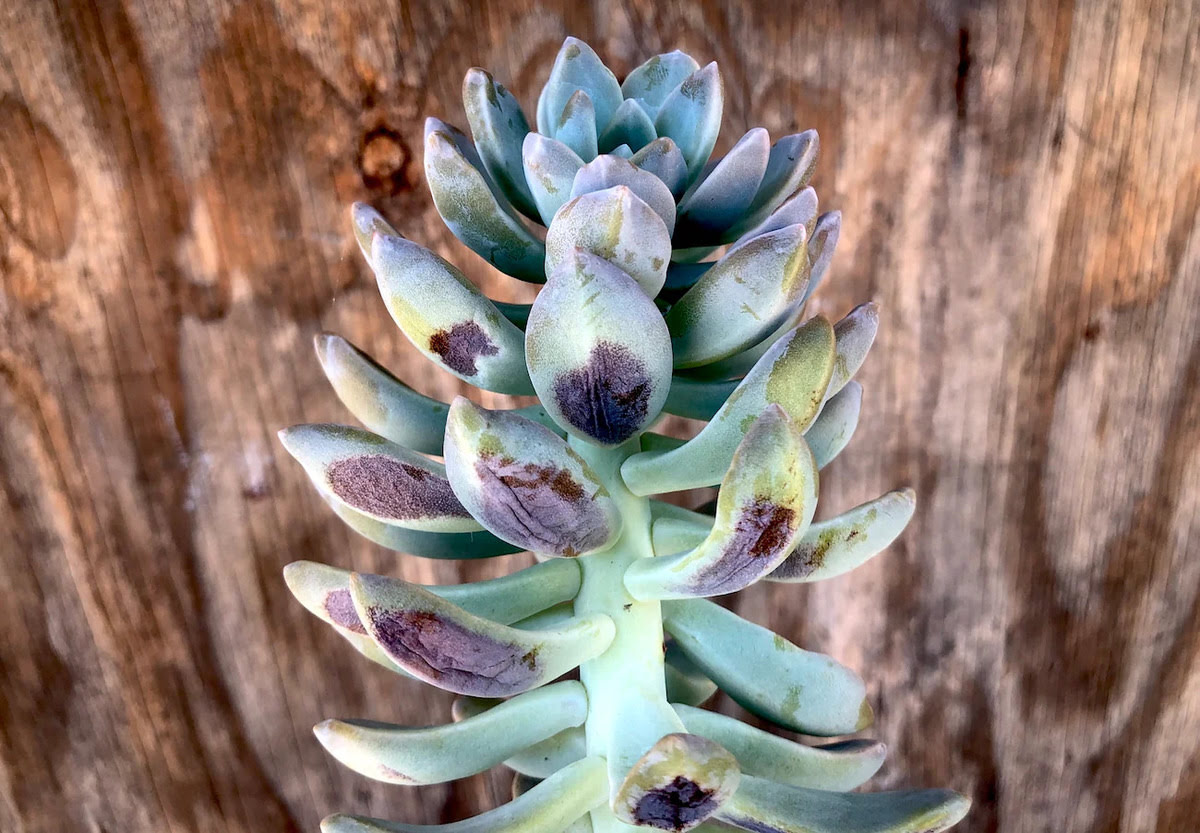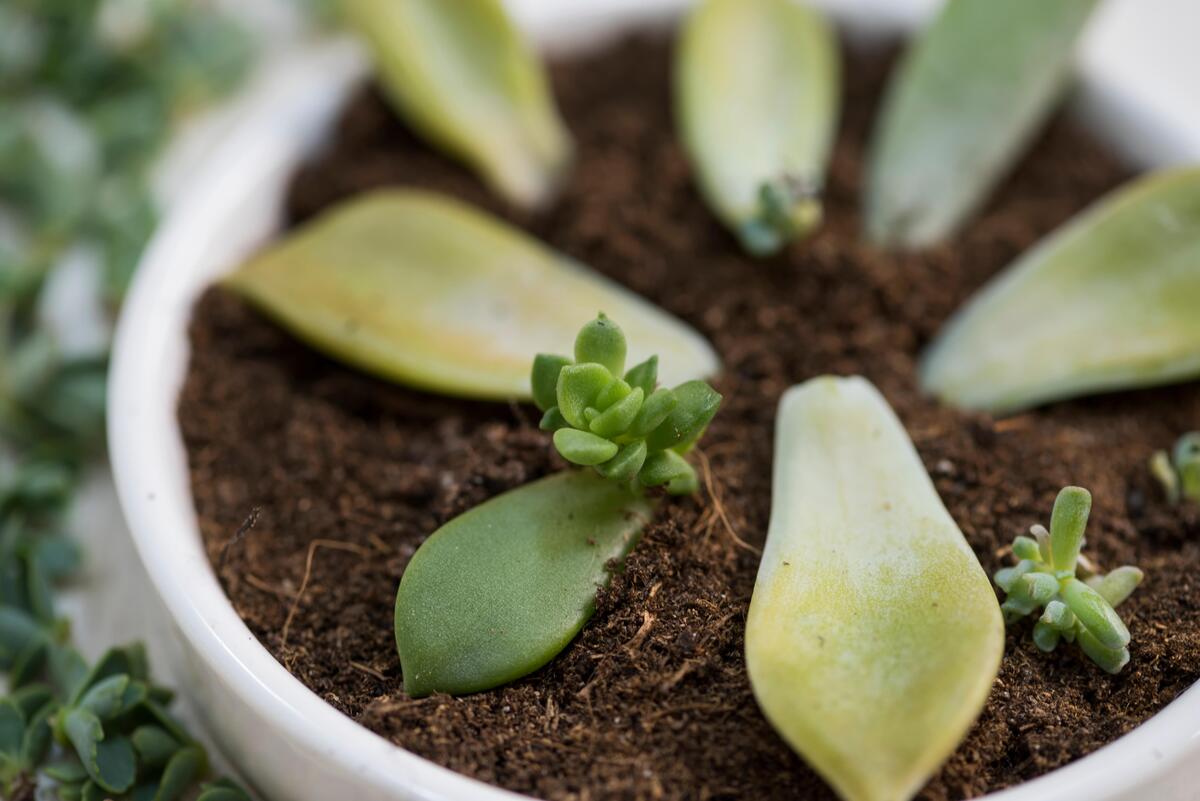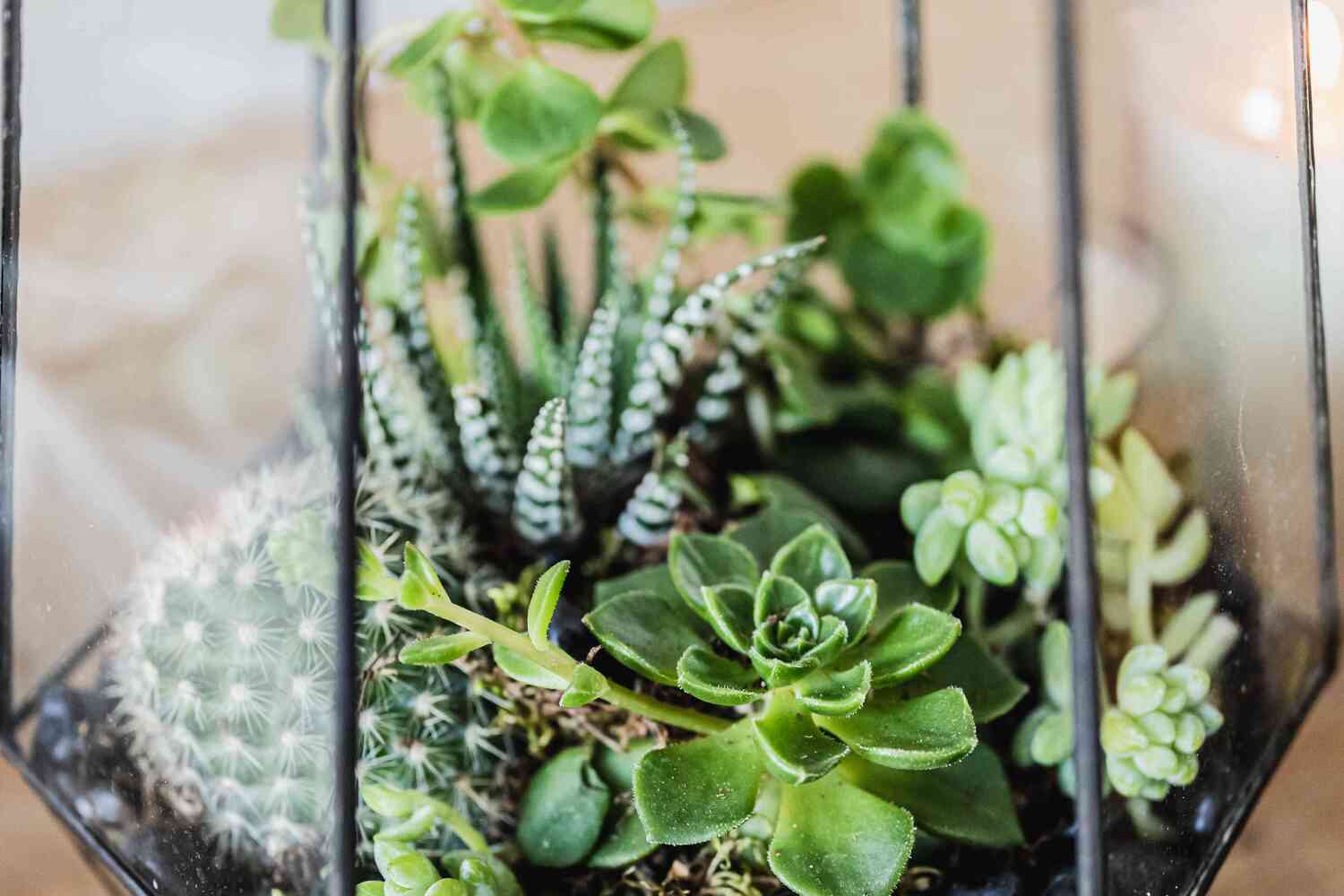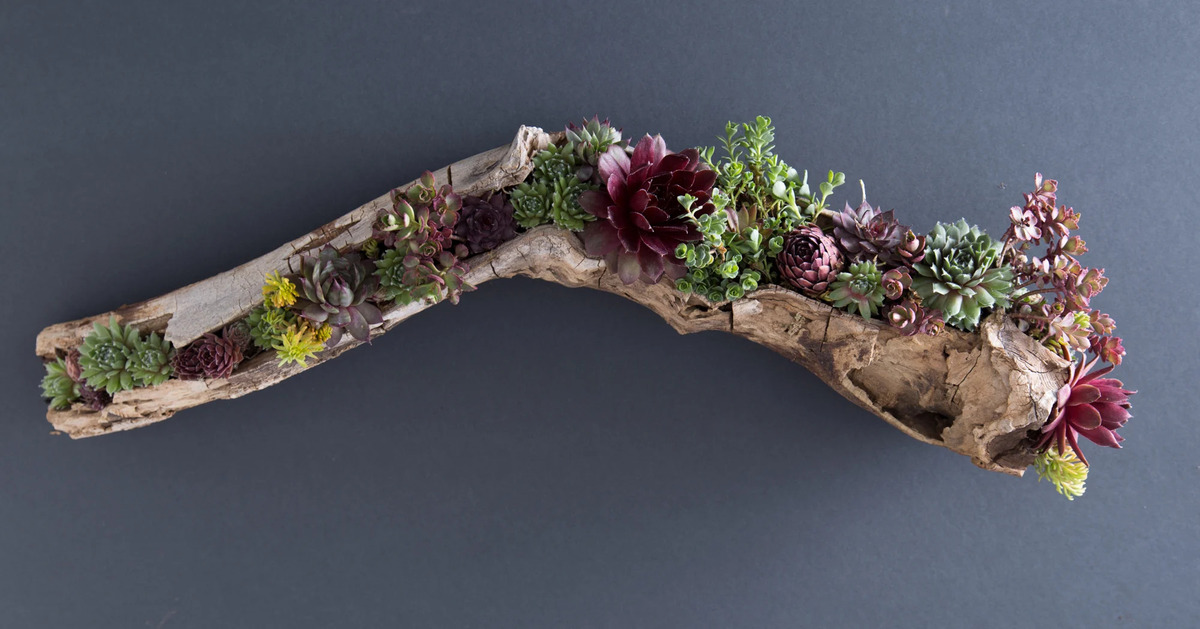Home>Gardening Tips and Tricks>Problem Solving>How To Heal Sunburned Succulents


Problem Solving
How To Heal Sunburned Succulents
Modified: February 9, 2024
Learn how to solve the problem of sunburned succulents and heal them effectively with our expert tips and advice.
(Many of the links in this article redirect to a specific reviewed product. Your purchase of these products through affiliate links helps to generate commission for Chicagolandgardening.com, at no extra cost. Learn more)
Table of Contents
Introduction
Succulents are known for their beautiful and unique appearance. These hardy plants have adapted to survive in arid conditions with minimal water. However, even the toughest succulents can suffer from sunburn if exposed to intense sunlight for extended periods. Sunburned succulents can develop unsightly brown patches, wilting leaves, and even die if not treated promptly. In this article, we will explore how to heal sunburned succulents and restore them to their former vibrant glory.
Understanding the causes and symptoms of sunburned succulents is crucial for proper treatment. Succulents usually grow in arid regions where they receive bright but indirect sunlight. When exposed to intense, direct sunlight for prolonged periods, the plants can become overwhelmed and suffer from sunburn. This occurs when the plant’s tissues are unable to cope with the excessive heat and UV radiation, leading to cell damage and discoloration. Common symptoms of sunburned succulents include pale or brown patches on the leaves, wilting or shriveling, and crispy or brittle texture.
Assessing the extent of the damage to your succulents is essential before implementing any treatment. Mild cases of sunburn can be easily reversed with proper care and attention, while severe cases may require more extensive measures. Look closely at your succulents to determine the extent of sunburn damage. Are only a few leaves affected, or have the majority of the plant’s foliage been impacted? It’s important to take note of the severity and location of the sunburned areas before proceeding with treatment.
Providing immediate relief to sunburned succulents is crucial to prevent further damage and promote healing. The first step is to remove the succulent from direct sunlight and find a shady spot for it to recover. This will shield the plant from intense heat and give it a chance to recuperate. Next, refrain from watering the plant immediately after sunburn as excessive moisture can worsen the condition. Allow the soil to dry completely before resuming regular watering practices. We will discuss proper watering techniques in more detail later in this article.
Understanding Sunburned Succulents
Sunburn in succulents occurs when they are exposed to excessive amounts of direct sunlight, especially during the hottest parts of the day. While succulents are known for their ability to tolerate drought and bright light, prolonged exposure to intense sunlight can cause damage to their delicate tissues.
Sunburn in succulents is characterized by discolored patches on the leaves, ranging from pale brown to dark brown. The affected areas may appear shriveled, crispy, or wilted. In severe cases, the leaves can become scorched and develop sunken brown spots.
It’s important to note that not all succulents are equally prone to sunburn. Some varieties, such as Echeverias and Haworthias, have thicker foliage and are more tolerant of direct sunlight. On the other hand, succulents with thinner leaves, like Sedums and Sempervivums, are more susceptible to sunburn and require more protection.
Understanding the factors that contribute to sunburn in succulents can help prevent and mitigate the damage. Here are a few key factors to consider:
- Intensity of sunlight: Succulents are adapted to thrive in bright light, but intense, direct sunlight for extended periods can be harmful to their tissues. This is especially true for succulents that are accustomed to growing in shaded or partially shaded areas.
- Duration of exposure: The longer a succulent is exposed to intense sunlight, the higher the risk of sunburn. It’s important to monitor the duration of sunlight exposure and provide shade during the hottest parts of the day.
- Temperature: High temperatures, in combination with intense sunlight, can exacerbate sunburn in succulents. During heatwaves or in hot climates, it’s crucial to take extra precautions to protect your succulents.
- Watering practices: Overwatering can weaken succulents and make them more susceptible to sunburn. When the leaves are full of water, they act as magnifying glasses, intensifying the effects of the sun’s rays. It’s important to establish a proper watering routine to avoid overwatering.
By understanding these factors and adjusting your care practices accordingly, you can help prevent sunburn in your succulents and ensure their long-term health and beauty.
Assessing the Damage
Once you notice signs of sunburn on your succulent, it’s essential to assess the extent of the damage. Understanding the severity of the sunburn will help you determine the appropriate course of action to treat and heal your succulent.
Begin by closely examining your succulent’s leaves for any discoloration or browning. Pay attention to the intensity and spread of the sunburned areas. If only a few leaves are affected, the damage is likely mild. However, if a significant portion of the plant’s foliage is affected, the sunburn may be more severe.
Sunburned leaves will often appear discolored, ranging from pale brown to dark brown. In the initial stages, the leaves may start to show signs of wilting or shriveling. As the sunburn progresses, the affected leaves may become crispy or develop a brittle texture.
In severe cases, the leaves may develop sunken brown spots, indicating significant cell damage. If you notice these sunken spots or if the entire leaf has become dried out and crispy, the damage may be more extensive.
Assessing the damage will help guide your treatment strategy. Mild cases of sunburn can often be reversed with proper care and attention. However, if the damage is severe and widespread, it may be more challenging to save the succulent. In such cases, you may need to consider propagating healthy leaves or cuttings to preserve the genetics of the plant.
When assessing the damage, take note of the location of the sunburned areas. If the majority of the damage is concentrated on the lower leaves and stem, it could indicate that the plant wasn’t getting enough light and was stretching towards the sun. On the other hand, if the damage is mainly on the upper leaves, it suggests that the succulent was exposed to intense sunlight.
By carefully evaluating the extent and location of the sunburn, you’ll be better equipped to provide the necessary care and treatments to help your succulent recover and thrive once again.
Providing Immediate Relief
When you discover that your succulent has suffered from sunburn, providing immediate relief is crucial to prevent further damage and promote healing. Taking swift action can significantly increase the chances of your succulent recovering from the sunburned condition.
The first step in providing immediate relief is to remove your succulent from direct sunlight. Find a shaded area or bring the plant indoors where it can be shielded from intense heat and UV rays. This will allow the succulent to recover without further stress from the sun. Be sure to choose a location that still provides some indirect light, as completely depriving the plant of light can have negative consequences.
It’s important to refrain from watering your succulent immediately after it experiences sunburn. Excessive moisture can worsen the condition by promoting the growth of harmful fungi or bacteria. Allow the soil to completely dry out before resuming your regular watering routine. This will give the succulent’s roots a chance to recover and prevent potential root rot.
In some cases, you may choose to rinse your succulent with clean, lukewarm water to remove any dust or debris that may have accumulated on its leaves. Gently spray the plant, focusing on the areas that are sunburned. This can help cool down the leaves and wash away any potential pests that may have been attracted to the damaged foliage. However, avoid getting the soil too wet during this process.
Keep an eye on your succulent during the first few days after providing immediate relief. The plant may take some time to recover, and it’s normal for the sunburned leaves to eventually dry up and fall off. Continue to monitor the plant’s overall health and make adjustments to your care routine as needed.
Providing immediate relief to your sunburned succulent is the first step in its healing journey. By removing it from direct sunlight, allowing the soil to dry out, and potentially rinsing it with water, you’re giving the plant the best chance to recover and regain its vitality.
Creating a Healing Environment
Creating a healing environment for your sunburned succulent is crucial for its recovery and overall well-being. By providing the right conditions, you can help the plant recover from the damage caused by the sunburn and encourage healthy growth.
One of the key elements in creating a healing environment is to find the ideal location for your succulent. Choose a spot that provides bright, indirect light rather than direct sunlight. Indirect light will allow the succulent to receive the necessary energy for photosynthesis without overwhelming its damaged tissues. A north-facing window or an area shaded by a sheer curtain can be ideal for this purpose.
Proper air circulation is also important for the healing process. Ensure that the succulent is placed in a well-ventilated area to prevent the buildup of excess humidity, which can contribute to fungal or bacterial growth. Avoid placing your succulent near heating or cooling vents, as abrupt temperature changes can stress the plant further.
The temperature in the healing environment should be within the optimal range for your succulent species. Most succulents prefer temperatures between 65°F and 85°F (18°C to 29°C). Avoid exposing the succulent to drastic temperature fluctuations or extreme heat, which can further damage the already fragile tissues.
Humidity is another factor to consider when creating a healing environment. Most succulents thrive in low humidity environments, so it’s important to avoid any excessive moisture that can lead to rot or fungal issues. If the air in your home is particularly dry, you can increase the humidity around the succulent by placing a tray of water near it or using a humidifier. However, be cautious not to create an environment that is too humid, as that can also have adverse effects.
Lastly, it’s important to keep the healing environment free from pests. Sunburned succulents may attract pests like mealybugs or spider mites, which can further weaken the plant. Regularly inspect your succulent for any signs of pests and take appropriate measures to eliminate them, such as using natural pest control methods or insecticidal soap.
By creating a healing environment with the right lighting, temperature, air circulation, humidity levels, and pest control, you are providing the optimal conditions for your sunburned succulent to recover and thrive once again.
Adjusting the Lighting
Adjusting the lighting conditions for your sunburned succulent is an essential step in its healing process. By providing the right amount and intensity of light, you can ensure that the plant receives the necessary energy for recovery without causing further damage to its already sensitive tissues.
If your succulent has experienced sunburn, it is crucial to move it to a location with bright, indirect light. Direct sunlight should be avoided, especially during the hottest parts of the day. Look for a spot near a window where the succulent can receive bright, filtered light. Placing sheer curtains or using a light diffuser can help further reduce the intensity of the sunlight reaching the plant.
You can also consider using artificial grow lights if you do not have access to a suitable natural light source. LED grow lights are a popular choice for succulents as they provide a balanced spectrum of light and can be adjusted in terms of intensity and duration. Position the grow lights at an appropriate distance from the succulent to avoid burning the leaves.
Monitoring the lighting conditions is essential as different succulent species have varying light requirements. Some succulents, like Echeverias and Haworthias, prefer bright but indirect light and can tolerate partial shade. On the other hand, succulents with thinner leaves, like Sedums and Sempervivums, may require more exposure to direct sunlight. Researching the specific light requirements of your succulent species can help guide you in providing the optimal lighting conditions.
Rotate your succulent regularly to ensure even exposure to light. This will prevent the plant from leaning or stretching toward a specific light source, which can lead to etiolation. By rotating the succulent every few weeks, all sides of the plant will receive equal amounts of light, resulting in more balanced growth.
Continue monitoring the succulent’s response to the adjusted lighting conditions. If you notice any signs of stress, such as wilting or discoloration, it may indicate that the lighting needs further adjustment. Conversely, if you observe new growth and an improvement in the overall health of the succulent, it’s a positive sign that you’ve provided the right lighting conditions for its recovery.
By carefully adjusting the lighting conditions for your sunburned succulent and considering its specific light requirements, you can create an environment that promotes healing and encourages healthy foliage growth.
Watering and Moisture Control
Proper watering and moisture control are crucial considerations when it comes to healing sunburned succulents. Finding the right balance between providing enough water for the plant’s recovery and avoiding too much moisture is essential in promoting healing and preventing further damage.
After your succulent experiences sunburn, it is important to give it some time to recover before resuming regular watering. When succulents are sunburned, their damaged tissues cannot efficiently absorb water. Therefore, it is best to let the soil dry out completely before watering again. This will prevent the risk of overhydration and the development of root rot.
When you do resume watering, make sure to water your succulent thoroughly. Water should be evenly distributed throughout the potting soil until it starts draining from the drainage holes. This ensures that the entire root system receives hydration. Allow the excess water to drain away completely to avoid waterlogged soil.
Establish a watering schedule that suits the specific needs of your succulent species. Most succulents prefer a drier environment, so it’s important not to overwater. Wait for the soil to dry out completely before watering again. It’s better to underwater than to overwater, as succulents are more tolerant of drought stress than excess moisture.
You can also adjust the frequency of watering depending on the season and environmental conditions. During the cooler months or in a more humid climate, succulents generally require less frequent watering. Conversely, in hotter and drier conditions, you may need to increase the watering frequency, but always prioritize thorough drying between waterings.
Moisture control extends beyond watering practices. It is important to provide adequate airflow and ventilation around your succulent to prevent excess humidity. Avoid placing succulents in areas with high humidity or near sources of moisture, such as bathrooms or kitchens. Good air circulation helps prevent the growth of fungi and bacteria, which can further damage sunburned succulents.
Monitoring the moisture levels in the soil is critical for proper care. Invest in a moisture meter or simply use your finger to check the moisture level in the soil. If it feels dry up to your first knuckle, it’s an indication that it’s time to water. However, if it still feels moist, hold off on watering until the soil has dried out.
By adjusting your watering practices and ensuring proper moisture control, you can promote the healing process in your sunburned succulent and provide the conditions it needs to thrive.
Applying Topical Treatments
Applying topical treatments can be beneficial in aiding the healing process of sunburned succulents. These treatments can provide additional support to damaged tissues and help prevent infection or further damage. While not all succulents may require topical treatments, they can be effective in certain cases.
One common topical treatment for sunburned succulents is aloe vera gel. Aloe vera has soothing and healing properties that can help alleviate pain, reduce inflammation, and promote tissue regeneration. Simply apply a thin layer of fresh aloe vera gel directly onto the sunburned areas of your succulent. Allow it to dry before placing the plant back in its healing environment. Aloe vera gel can be applied once or twice a week, or as needed.
Another option is to use diluted hydrogen peroxide to disinfect any sunburned areas. Mix equal parts of hydrogen peroxide and water, then use a soft cloth or cotton pad to gently dab the mixture onto the affected leaves. This can help prevent any potential infections or diseases from taking hold. However, be cautious not to use a concentration of hydrogen peroxide that is too strong, as it can damage the plant’s tissues.
In some cases, a diluted neem oil solution can be used to control any pests that may have been attracted to the damaged succulent. Mix a few drops of neem oil with water and apply it to the affected leaves using a spray bottle. Neem oil is a natural insecticide and can help eliminate pests like mealybugs or spider mites. However, make sure to read and follow the instructions on the neem oil product, as different concentrations may be required for different succulent species.
When applying any topical treatments, it’s important to handle your succulent with care. Use a soft cloth or a gentle touch to avoid causing any further damage to the sunburned leaves. Be mindful not to apply treatments to healthy foliage, as they are unnecessary and may potentially harm the plant.
Remember that topical treatments should be used alongside other essential care practices, such as adjusting the lighting, providing a healing environment, and proper watering. Be patient and consistent in your treatment approach, as it may take time for your succulent to recover from sunburn and show signs of improvement.
To determine the best treatment approach for your sunburned succulent, consider the severity of the sunburn, the specific needs of your succulent species, and the advice of seasoned succulent enthusiasts or experts. With proper care and the application of suitable topical treatments, your sunburned succulent can regain its health and beauty.
Pruning and Propagation
Pruning and propagation are important techniques to consider when dealing with sunburned succulents. Pruning helps to remove damaged or unsightly foliage, while propagation allows you to preserve the genetic material of the plant and start anew.
When pruning your sunburned succulent, start by identifying the leaves or stems that have been severely affected by the sunburn. Look for discolored, wilted, or shriveled sections. Using a clean and sharp pair of pruning shears or scissors, carefully trim away the damaged parts of the plant. Make sure to cut just above a node or joint to encourage new growth. Always sanitize your pruning tools before and after use to prevent the spread of any potential infections.
Pruning not only helps to remove unsightly parts of the succulent but also allows the plant to redirect its resources towards new growth. By removing the damaged foliage, you are providing a fresh start for the succulent to heal and thrive.
Propagation can be considered if a large portion of your succulent has been affected by sunburn. This technique allows you to create new plants from healthy leaves or stem cuttings. Start by carefully selecting healthy leaves or stems that have not been damaged by the sunburn. Gently remove these leaves or stems from the main plant, making sure to include a small portion of the base.
Place the leaves or cuttings in a shaded area to allow the wounds to callus over for a few days. Once calloused, plant the leaves or cuttings in a well-draining soil mix and lightly water. Mist the soil occasionally to increase humidity around the new propagations. Over time, roots will develop, and new plants will start to emerge.
Propagation not only helps in salvaging a sunburned succulent but also allows you to expand your collection of succulents. By creating new plants from healthy portions, you can continue to enjoy these resilient and beautiful plants.
Be patient during the propagation process as it can take several weeks or even months for new plants to establish themselves. Keep the propagated succulents in a healing environment with appropriate lighting, temperature, and moisture control to ensure their successful growth.
Remember to care for the remaining part of the original plant that was not propagated. With proper care and the healing techniques mentioned earlier, it may also recover and start showing signs of new growth.
Through the combined efforts of pruning and propagation, you can rejuvenate sunburned succulents and create new plants that will bring beauty to your succulent collection.
Patience and Long-Term Care
Patience is key when it comes to healing sunburned succulents and ensuring their long-term health. It’s important to remember that recovering from sunburn takes time, and each succulent may respond differently to the healing process. By practicing patience and providing consistent care, you can give your succulent the best chance of full recovery.
Continue to monitor your succulent’s progress over time. It’s normal for the damaged leaves to eventually dry up and fall off as the succulent recovers. New growth will emerge from the healthy parts of the plant, showing signs of rejuvenation and vitality.
Consistent long-term care is essential for maintaining the health of your sunburned succulent. Here are some key care practices to keep in mind:
- Lighting: Once your succulent has recovered from sunburn, continue to provide bright, indirect light. Adjust the lighting conditions based on the specific needs of your succulent species and the environmental conditions.
- Watering: Establish a regular watering routine that allows the soil to dry out completely between waterings. Succulents prefer drier conditions, so be cautious not to overwater.
- Fertilizing: Use a balanced, diluted succulent fertilizer according to the instructions provided. Avoid over-fertilizing, as this can lead to nutrient imbalances and harm the plant.
- Pest control: Regularly inspect your succulent for pests and promptly treat any infestations. Keep the healing environment well-ventilated and use natural pest control methods whenever possible.
- Monitoring: Continuously assess the overall health of your succulent by observing its growth and appearance. Address any issues promptly to prevent them from escalating.
- Seasonal adjustments: Be aware of seasonal changes and adjust your care routine accordingly. Succulents may require less frequent watering during cooler months or in more humid conditions.
Remember that each succulent is unique, and understanding its individual preferences and needs is important for long-term care. As you gain experience caring for succulents, you’ll become more attuned to their specific requirements and be able to provide the optimal care for their continued well-being.
By practicing patience, providing consistent care, and adapting to the changing needs of your succulent, you can ensure its long-term health and enjoy the beauty of a thriving, sunburn-free succulent.
Conclusion
Sunburned succulents can be a cause for concern, but with the right knowledge and care, they can recover and thrive once again. Understanding the causes and symptoms of sunburn helps in preventing future damage. Assessing the extent of the damage informs the appropriate treatment plan. Providing immediate relief by removing the succulent from direct sunlight and allowing the soil to dry is crucial. Creating a healing environment with proper lighting, temperature, air circulation, and humidity control promotes the succulent’s recovery. Adjusting the lighting to provide bright, indirect light ensures optimal growth. Proper watering techniques and moisture control prevent overhydration and promote healing. Applying topical treatments like aloe vera gel or hydrogen peroxide can aid in the recovery process. Pruning and propagation help remove damaged parts and create new plants. Patience and long-term care, including consistent watering, monitoring, and adjusting care based on seasonal changes, are essential for the succulent’s ongoing well-being.
Remember, each succulent is unique, and it’s important to observe and cater to its specific needs. With proper care, patience, and attention to detail, you can successfully heal and restore sunburned succulents, creating a beautiful and thriving collection of these resilient plants.










